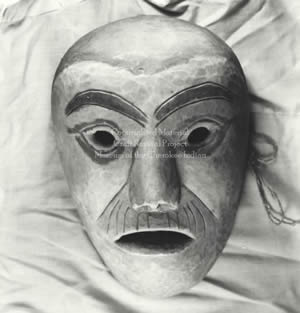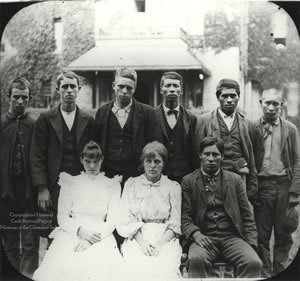People: Will West Long (1870 - 1947)
An accomplished mask maker and master of Cherokee dance and drama, Will West Long (1870-1947) was born in the remote western North Carolina community of Big Cove. Raised in the traditions of the Cherokee, Long attended Hampton Institute in Virginia when he was 25 years old. He lived off the Qualla Boundary until 1904, when he returned to Big Cove, where he remained for the rest of his life. For almost 30 years, Long served on Tribal Council, where he was instrumental in establishing the Cherokee Indian Fair, among other accomplishments. He recorded his knowledge regarding Cherokee medicine, carving, music and dance, and language with the hope of preserving tradition. Long was a consultant for ethnologists, James Mooney, Frank Speck, and Franz Olbrechts.
Will West Long is almost a legendary figure among the Eastern Band of Cherokee Indians. He was a generation older than any of the other carvers included here. Long was born as Wili Westi in 1870, less than fifty years after the Removal of the eastern Cherokee to Oklahoma. No doubt many of the adults he knew growing up had experienced this cataclysmic disruption firsthand. Long lived in Big Cove, a community often noted to be the most traditional. His father, John Long was a Baptist preacher; his mother was Sally Terrapin or Ayasta, a medicine woman. Frank Speck, an American ethnologist, recorded Long’s reminiscence. “Wild turkeys were everywhere,” he remembered. “The deer and elk furnished us our clothing and moccasins...Squirrels, rabbits, bears, deer, elk, all the meat we wanted. We killed some with bows and arrows and trapped...We had fish hooks cut out of bone.” Although some would characterize late 19th century living as a hardscrabble life, Long recalled its abundance and harmony with nature.
While Long was a young teen, he was sent to Trinity College (now Duke University), one of the only schools in North Carolina to accept Native American students. According to an article written shortly after his death, he spent “several lonely months” there and then ran away, “hiding and sleeping during the daytime and walking at night.” Returning home to the Qualla Boundary in 1887, Long encountered James Mooney during his first visit to Cherokee. Mooney came to collect stories, artifacts, songs, and lore for the Smithsonian Institution. For Mooney, the young Will West Long served as a translator, scribe, and interpreter of culture. At age twenty, Long again left home for Hampton Institute, where he lived and studied for five years. He spent ten years in New England, going to school and working in various places, including Boston. He returned in 1904, shortly before his mother’s death and never left Big Cove for any period of time.
Will West Long was the key informant for practically every ethnologist, anthropologist, and archeologist who visited Cherokee. He was indispensable to Mooney and M. R. Harrington in the late 19th century, and later to Franz Olbrechts and Frank Speck in the early 20th century. In addition to being a repository of knowledge about Cherokee culture and folklore, especially concerning medicine and spiritual practices, Long was a talented woodworker who was known for his hand carved dance masks. He learned to carve from his cousin Charley Lawson and learned songs and dances from the older men of Big Cove. In the 1940s, he was listed as a woodworker on an inventory of craftsmen made in preparation for establishing the artisan guild that would become Qualla Arts and Crafts Mutual. Long made sets of masks for Mooney, Harrington, Olbrechts, and Speck and was photographed making them by W. N. Fenton and Lester Hargrett in 1946. A few years after returning to Cherokee, Long married. His son Allen recalled the social and ceremonial dances that he witnessed growing up, noting that they were performed with a “great deal of secrecy.” While Allen Long remembered these dances from his childhood, they had all but disappeared as he grew into an adult. While many traditions were carefully guarded secrets, when he could, the elder Long shared openly. The 1930s and 1940s-era photographs showing him dancing and carving are a unique period record. At the time of his death, Long was engaged in translating and interpreting a number of writings on botanical medicine and Cherokee language. He was listed posthumously as co-author of Speck and Broom’s text on Cherokee Dance and Drama (1950). Many of Long’s original writings are in the Frank Speck Cherokee Collection at the American Philosophical Society.
Besides his well-documented work with outsiders, Will West Long served his community as well. For twenty-eight years he was a member of Tribal Council. In 1912 and 1913, Long and residents of Big Cove held a community fair that was to grow into the annual Cherokee Indian Fair. After the larger fair was established, he continued to work with the program, serving as a fair director from 1932 until 1946. A 1937 publication reported that Long was teaching the Cherokee language at the Cherokee Central School. In a later article, written in 1948, shortly after his death, anthropologist John Witthoft noted that Long’s “knowledge of Cherokee culture and his ability in the interpretation of the Cherokee language were second to none…. He participated in almost every study of either subject pursued during the past sixty years.”
Anna Fariello
Excerpted from Cherokee Carving: From the Hands of our Elders, 2013
Works Cited
The Eastern Cherokees: How they live today / their history (Knoxville: J. L. Caton, 1937).
Ingram, Jill Elizabeth. Man in the Middle: The Boarding School Education of Will West Long. M. A. Thesis (Western Carolina University, 2008).
Mails, Thomas E. The Cherokee People: The Story of the Cherokees from Earliest Origins to Contemporary Times (Tulsa: Council Oak Books, 1992).
Mooney, James. Myths of the Cherokee (Washington DC: Government Printing Office, 1902).
Speck, Frank and Leonard Broom. Cherokee Dance and Drama (Norman, OK: 1951).
Witthoft, John. “Will West Long, Cherokee Informant,” American Anthropologist 50.2 (1948).







